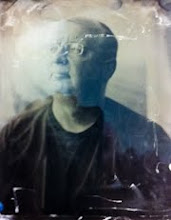Title: "The lies we tell ourselves and others"
(Click to view larger)
I've just started reading "Gerhard Richter: A Life in Painting" by Dietmar Elgar. On the back cover are two quotes from Richter. The first, dated 1966 reads "I pursue no objectives, no system, no tendency; I have no programme, no style, no direction. I have no time for specialized concerns, working themes or variations that lead to mastery. I steer clear of definitions. I don't know what I want. I am inconsistent, non-commital, passive; I like the indefinite, the boundless; I like continual uncertainty." In part, this reads like a passionate defiance of the art establishment, a refusal to be categorized or have motives attached by others to his work. I love that final sentence, the idea of liking continual uncertainty. Can one follow uncertainty, use it as a platform for making images? By its very nature, uncertainty cannot be followed - how to know where to turn next? Yet it can be an intoxicating platform for making images as long as one is willing to accept the unexpected.
The second quote, dated 1992 is in part a repudiation of the earlier quote although one must bear in mind the influence of hindsight. Richter is quoted as saying "That [meaning the 1966 quote] was an attempt at self-protection - saying that I was indifferent, that I didn't care, and so on. I was afraid my pictures might seem too sentimental. But I don't mind admitting now that it was no coincidence that I painted things that mattered to me personally - the tragic types, the murderers and suicides, the failures and so on." Again, I really like that last sentence. It reminds me that soon after we first moved to our island paradise, I was taken along to a meeting of the local camera club. What followed was a mind numbing parade of images of all the beautiful flowers to be found locally. One member allowed as how she had brushed off some dew drops from one subject as they detracted from the flower's beauty. I remember having a violent reaction to all this, wanting to immediately go out and find the seedy side of town, take pictures that shocked of subjects too horrible and ugly to stomach.
One of the things Richter is famous for is his paintings of photographs, often rendered blurry. I learned from what I've read of the biography so far that in the early days after leaving East Germany, Richter routinely burned his work because he felt it did not yet lead to what he was truly connected to. The first paintings to survive were his first paintings of photographs. There's an important distinction here - he did not do paintings based on photographs, rather the photographs were the subjects of the paintings. Richter chose photographs from newspapers, magazines and family snapshots. He chose to paint these photographs because they typically lacked any formal compositional elements, and by making them the objects of the paintings, he was in turn freed from making an compositional impositions on the works, unlike painting a landscape, a still life or an abstract. In addition, the painting took the photograph out of the context in which it had been originally presented.
According to the biographer, these paintings do not transmit well as reproduced images, because the surfaces of each were given very careful consideration by Richter, and are an important part of properly experiencing the work. I dearly would love to see some of those works in person to have that experience. Photographs typically have very even, regular surfaces, so the surface of the paintings bring new information to the photographic subjects. It would be wonderful to know what that additional information conveys.


No comments:
Post a Comment